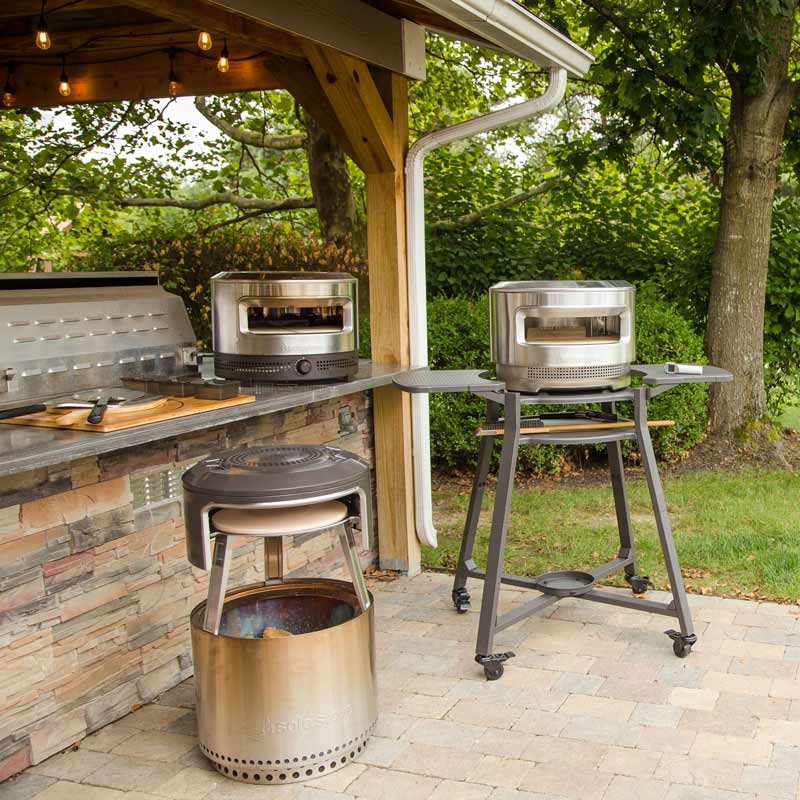
Solo Stove just released their 3rd pizza oven The Pi Prime, and that seemed like the perfect opportunity for a Solo Stove pizza oven comparison, or a Pi fight, if you will.
We've been big fans of Solo Stove fire pits for years, and about a year ago they entered the pizza oven arena with the release of the Pi Pizza oven. The Pi Fire followed not long after, and now their latest release, the Pi Prime.
When one brand offers 3 different versions of the same thing, we like to dig deeper to figure out who each one fits best. Let's take a look at the contenders.
Which Solo Stove Pizza Oven is Best?

Solo Stove Pi
First we have the Pi Pizza Oven, currently priced at $399. At that price it comes out of the box as a wood fueled pizza oven. For an additional $130 more you can add a gas burner to your bundle and have the option to cook with propane or wood.

Solo Stove Pi Fire
The Pi Fire is a little different in that it only works if you also have a Solo Stove fire pit to fuel it. And since the fire pits come in 3 sizes, guess what? The Pi Fire is also available in 3 sizes to fit your Yukon, Bonfire, or Ranger. We have the Bonfire set here, and this Pi Fire alone is currently priced at $259.99.

Solo Stove Pi Prime
And that brings us to the brand new Pi Prime, Solo Stove's first ever gas-only fueled pizza oven, which is being released with a retail price of $349.99, a price that's very competitive in the market.
Comparing Size of Solo Stove Pizza Ovens
When it comes to size, all three of these options are pretty comparable. In fact, as far as I can see the Pi and the Pi Prime are very nearly identical in size and footprint, with the Prime coming in at less than a pound lighter than the original Pi. Both of these ovens have a 13" pizza stone.
The size of the Pi Fire depends on the size of the fire pit. Our Bonfire Pi Fire has a slightly larger 14" stone and weighs just under 20 pounds.
Original Pi | Pi Prime | Bonfire Pi Fire | |
|---|---|---|---|
Pizza Stone Size | 13" | 13" | 14" |
Weight | 30.5 lbs | 30 lbs | 19.6 lbs |
Height/Diameter | H 15.125" x D 20.5" | H 15.5" x D 20.5" | H 16.9" x D 19.3" |
Cooking Pizzas in Solo Stove Pizza Ovens
We cooked a few 12" pizzas in each oven to compare the experience. We used the Solo Stove dough balls for these cooks, and you can get the same frozen dough shipped to you. If you're interested in making pizza night a little easier, we'll put a link in the description below for where you can order their frozen Neapolitan dough balls for your next pizza party.
Solo Stove Pi Prime

Cooking pizzas in the Pi Prime was really simple once we learned one very valuable lesson.
The oven heated up quickly and was ready to cook pizzas in probably under 20 minutes. I love that the gas burner knob is right in the front of the oven so you can see when you make minor adjustments to the flame.
We learned on our first pizza that the flame is strong and it works best to dial it down to medium once the pizza goes in to ensure an even cook. Overall this is a really clean pizza oven to use and the only real mess was from the semolina coming off the peel during the launch.
Original Pi Pizza Oven with Wood

We first set up the original Pi to cook with wood, using small pieces of the cherry we always have on hand here at the lab. Because we're working with small chunks of wood, we found that we had to feed the fire pretty frequently to keep the temperature of the oven somewhat consistent.
Even though we were burning hard wood, the pizza oven quickly collected a significant amount of soot around the front opening, however it did wipe clean easily with a dry paper towel when we were all done.
The pizzas cooked great and we did not have any issues with ash or embers getting in the way of the pizza, which is often a problem we run into in our wood burning pizza ovens.
Original Pi Pizza Oven with Gas
After cooking a few pies with wood we switched over to using the gas burner on the original Pi oven. It's a pretty simple change to make, but would have been even easier if I wasn't working with an already hot pizza oven.
Cooking pizzas in this oven with the gas burner is almost the exact same experience as the new Pi Prime, however the placement of the burner knob is admittedly less conveniently placed in the back of the oven.
Much like when cooking in the Pi Prime, we dialed the flame down a little after launching the pizza, but it was a little harder to make the adjustment with the knob in the back, so kudos to Solo Stove for bringing that knob up front in their newest model.
Pi Fire

Pizza's cooked in the Pi Fire look very different than in the other two ovens. The main difference is that the heat source is coming from below the oven rather than in the rear.
And on that same note, the light source is also not in the rear of the oven illuminating the pizza while it cooks. I found that the lack of back lighting coupled with the overall lower height of the pizza oven sitting on the fire pit made it more difficult to really observe what was going on with the cooking pizza.
On the plus side, since there was no direct flame access, we didn't have a need to rotate the pizza while it cooked, so if turning pizzas stresses you out, this might be a more relaxing setup to consider.
One downside that we noticed however, was that the pizzas came out of the oven with a definitive smoked-look which definitely made them appear to be less appealing than the others. I'm not really sure why that would be since we cook pizzas in wood ovens all the time and have never run into this before.
Even though the fire burns below the pizza oven, we did have to occasionally sweep ash and soot off of the pizza stone that had blown up from below. We did not find it challenging to feed the fire pit with the pizza oven in place; there was plenty of gap available and the Solo Stove fire pit tools were up to the task whenever we needed a little extra help positioning the wood.
Our Thoughts on the 3 Solo Stove Pizza Ovens
After cooking pizzas on all 3 ovens, here's my take-away.
If you've watched our channel you know that I'm usually pro wood-fire when it comes to cooking. I just love the smell that comes when I light up splits of cherry wood for a low and slow cook.
The thing about pizza ovens is, when you're cooking at this high of a temperature, the pizzas cook too fast to truly have a "wood" fire influence the flavor. There's very little to no smoke present when I have a fire running at 700+ degrees Fahrenheit, so running wood for flavor is really more marketing than it is a flavor reality.
If I'm working in a large pizza oven where I can watch the fire burn next to my cooking pizza, that adds to the overall experience and makes it more enjoyable for me personally. But in the case of smaller ovens like the Pi, where I can't really watch the fire burning very well, I wouldn't say that burning wood makes the experience more enjoyable or tasty than when cooking with gas.
However, I admit that my position on that is probably skewed since I have had the opportunity to cook in much larger wood pizza ovens.
I think my take is, if you're planning on cooking your pizzas with gas anyway, going with the Pi Prime is a no-brainer decision. It's a clean oven that cooks pizzas well and fast and is currently being sold at an impressive price.
If you don't mind getting a little dirty and prefer the additional experience of cooking with wood, the original Pi oven is still a solid option. I like it as a wood fired oven, but it's admittedly more work to keep a hot fire going between pizzas.
And lastly, if you're already team-Solo-Stove when it comes to fire pits and accessories and you enjoy sitting back and relaxing while your pizza cooks hands-free, the Pi Fire might be right up your alley. The downside to the Pi Fire is having to lean down to work with the pizza along with the lack of lighting to see how the back of the pizza is doing during a cook.
For just a few bucks more, you can have your fire pit AND an entire gas powered pizza oven. The price and performance of the Pi Prime make it a no brainer for me.
Solo Stove Warranty
All three of these ovens come with the Solo Stove lifetime warranty as well as a 30 day money back guarantee if you're not satisfied with your purchase. That's one of the many reasons we've enjoyed the Solo Stove brand.
Other Pizza-Making Tools are Essential
I’m a penny pincher and I know that when I’m about to make a big purchase like this, I tend to go with the very base package without all the extras included in whatever “bundles” are offered. But inevitably, I get my order delivered and then realize I really do need several of the items that had been offered in the bundles to even be able to get started. This is a classic case of that.
Solo Stove has put together 2 different bundles to make sure you don’t forget any of the other pizza oven accessories you need to get started. The starter bundle includes the Pi pizza oven, infrared thermometer, pizza peel, and pizza cutter. The essentials bundle includes everything from the starter bundle as well as the shelter and turning peel.
Pizza Peel
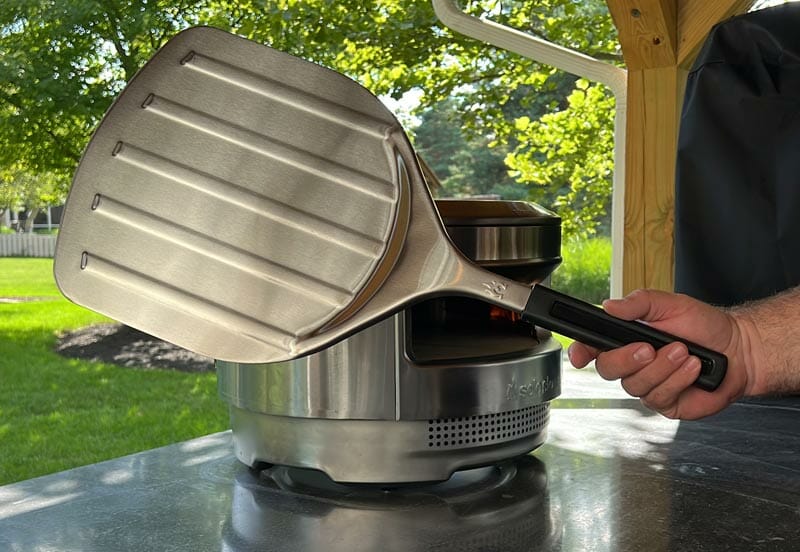
You could just order the Solo Stove Pi alone. But if that’s all you have, you’re not making pizzas in it. You absolutely under no uncertain terms MUST have a pizza peel. This is a non-negotiable item. It doesn’t have to be Solo Stove brand, but you must have a peel that will fit the opening of the pizza oven in which you’re cooking. Check the current price of the stainless steel peel.
Infrared Thermometer
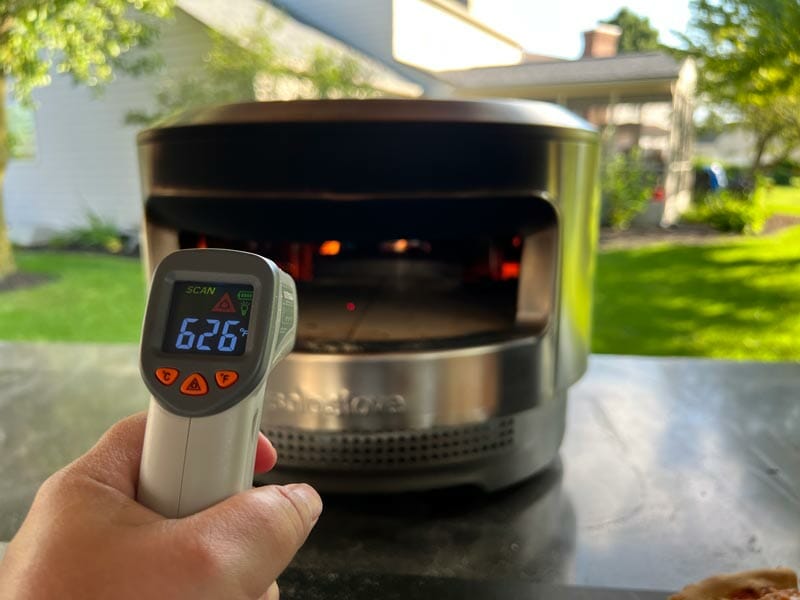
While you technically could start cooking pizzas if you only had a peel and an oven, an infrared thermometer is pretty important to see that you do it well. This is what tells you the surface temperature of the cordierite pizza stone on which you’ll be launching pizzas. If the pizza stone is too cool, your crust will be undercooked while your toppings burn. If the stone is too hot, your bottom crust may burn while the upper half of the pizza cooks. We try to shoot for a pizza stone temperature between 700-800°F before we launch our first pizza. Check the current price of the Solo Stove IR thermometer.
Turning Peel
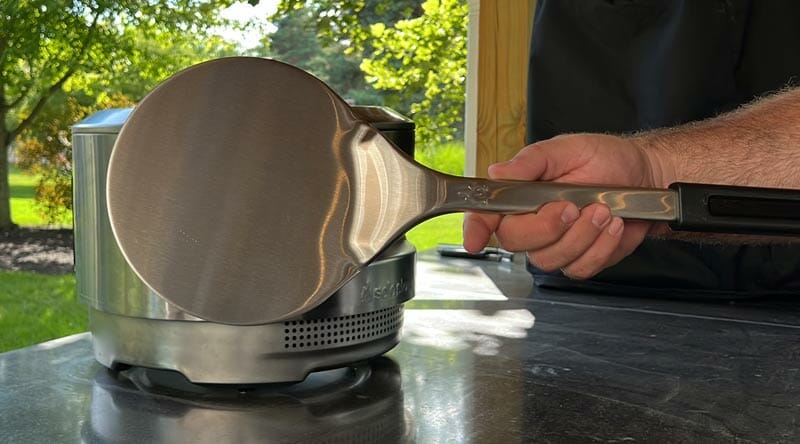
While the turning peel isn’t essential, it makes the job a lot easier. After you launch your pizza it will need to be turned, or rotated within the oven every 20-30 seconds. Without the turning peel you’d have to pull it mostly out on the regular peel, rotate the pizza on the peel with your fingers while whispering “hot! hot!” and then slide it back into the oven every 30 seconds. The turning peel is small enough that it allows you to rotate the pizza while staying inside the oven and protecting your fingers. Check the current price of the turning peel.

Pizza Cutter
The Solo Stove pizza cutter comes in both the starter bundle and the essentials bundle. It’s a pretty basic cutter, probably pretty similar to the one you already have in your kitchen drawer. Check the current price of the pizza cutter.
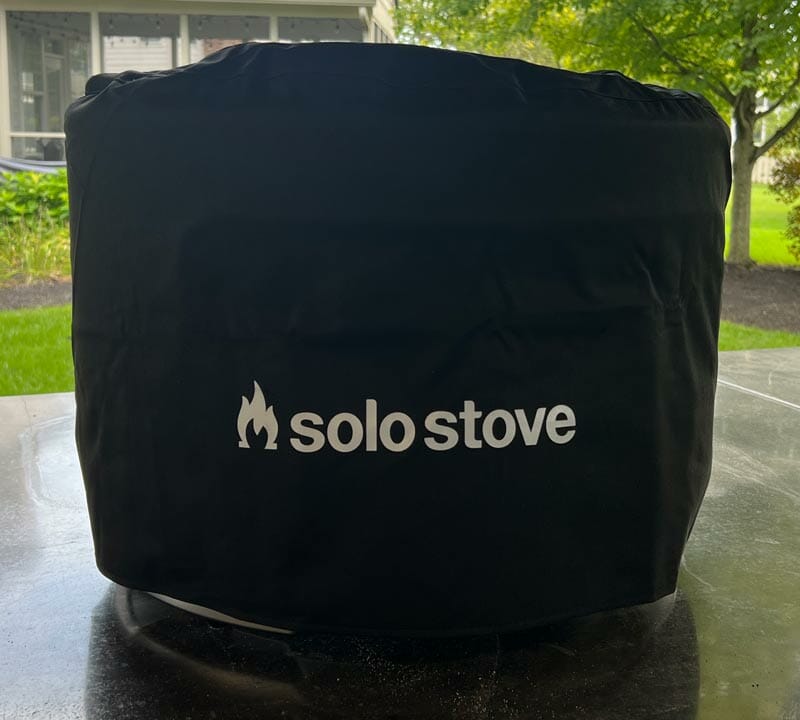
Shelter
If you plan on storing your Solo Stove Pi outside, you’re going to want a way to keep it covered and dry inside. Check the current price of the Solo Stove Pi Shelter.
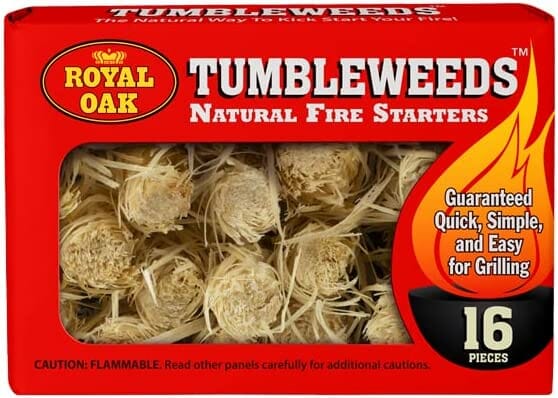
Fire Starters
Unless you plan on only using the additional gas burner, you’ll need at least one fire starter for each time you light up your pizza oven, burning wood. We prefer the tumbleweed-style starters.
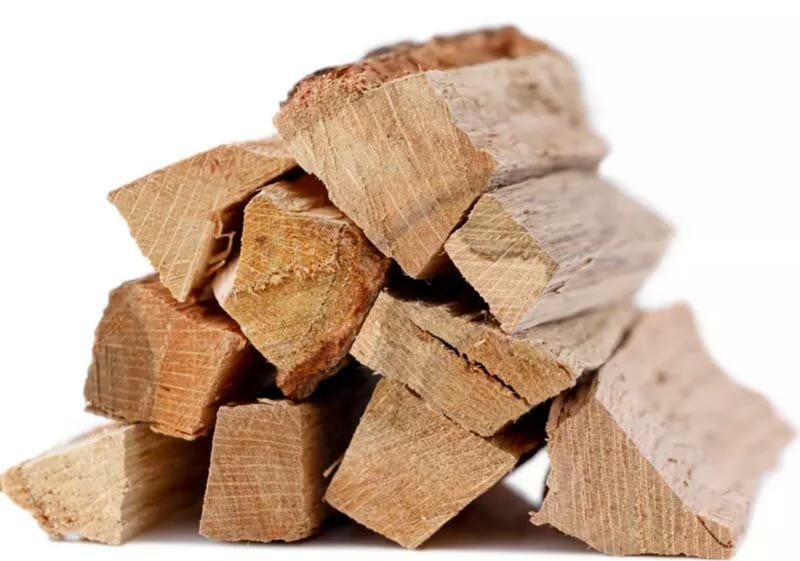
Small Fire Wood
You will not be able to just grab wood off your wood rack to fuel your pizza oven. You need pieces that are only 4-5″ long with a diameter of 1-2″ to fit in the wood burning assembly. As amazing as the kindling cracker is, it’s too much work for me so I’d just assume buy a box of cooking wood splits all ready to go.
How Does the Solo Stove Pi Compare With Ooni?
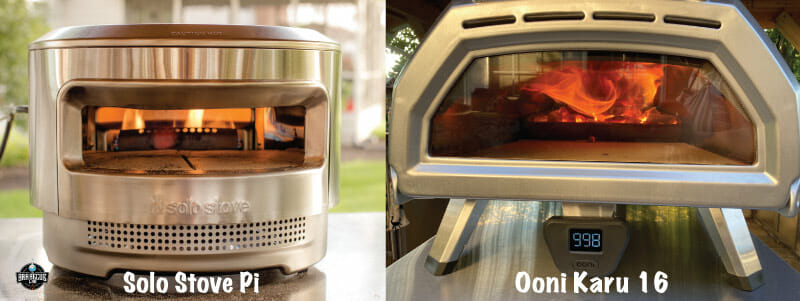
Why can you trust our review?
At the Barbecue Lab, we attempt to be as impartial as possible, collecting as much information as possible and allowing the data to speak for itself. Solo Stove provided us with the use of their product for a limited amount of time, but the content of this article and video are entirely our own; we have not been asked to say anything specific regarding the product. We have personally used this portable pizza oven multiple times, done our best to capture our experiences, and will let our readers and viewers decide for themselves if this particular oven fits their budget and their lifestyle.
Solo Stove vs. Ooni
I’ll start by disclaiming that it’s hard for me to put “vs.” between those two brand names because we’ve been big fans of both brands for quite some time! We’ve previously reviewed the Ooni Koda 16 and the Ooni Karu 16, but because of the significant size difference, we will be comparing the Solo Stove Pi to the Ooni Karu 12 as they have the most similarities.
Solo Stove Pizza Oven vs. Ooni Karu 12
Quick Comparison
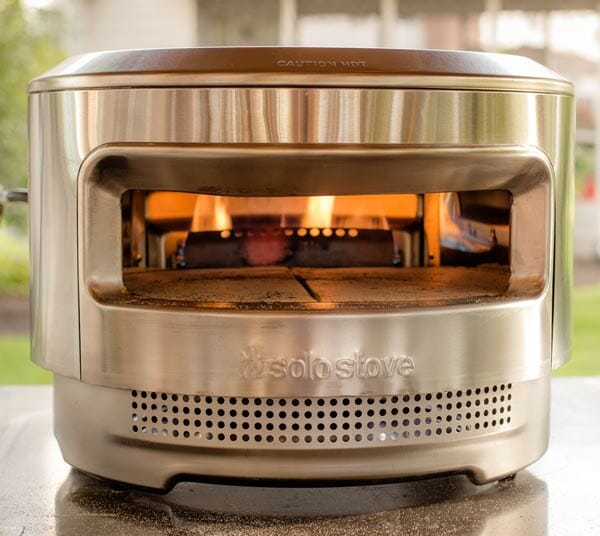
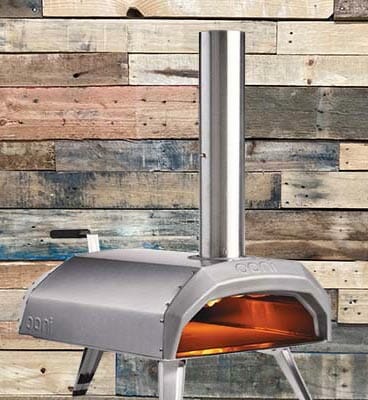
Pizza Oven | Solo Stove Pi | Ooni Karu 12 | |||
|---|---|---|---|---|---|
Dimensions |
|
| |||
Weight |
|
| |||
|
|
| |||
|
|
| |||
|
|
| |||
Fuel |
|
| |||
Warranty | Lifetime |
| |||
|
Wood Burning Assembly
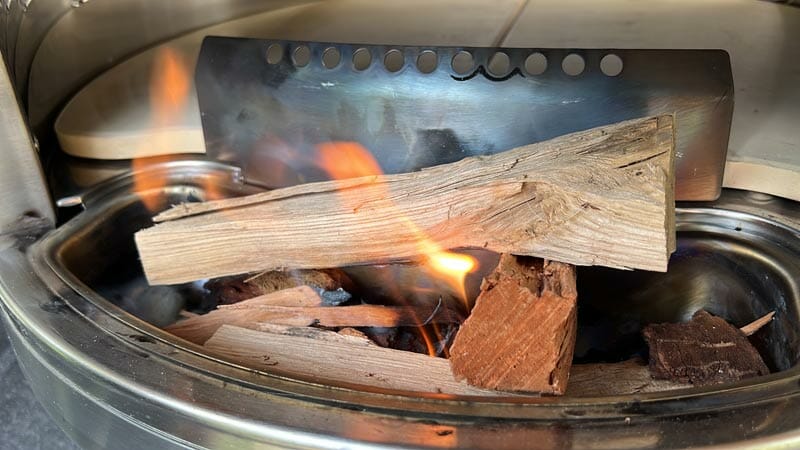
Both the Solo Stove Pi and the Ooni Karu 12 come out of the box as wood-fired pizza ovens.
The Solo Stove Pi comes with a wood-burning assembly that can burn small kiln-dried cuts of wood. There is a removable ash pan measuring roughly 10.5 inches wide by 3.5 inches deep in which you build your fire. The fire is accessed through a rear door that is removed and replaced with an included tool. The Pi also comes with a small tool for stoking the fire.
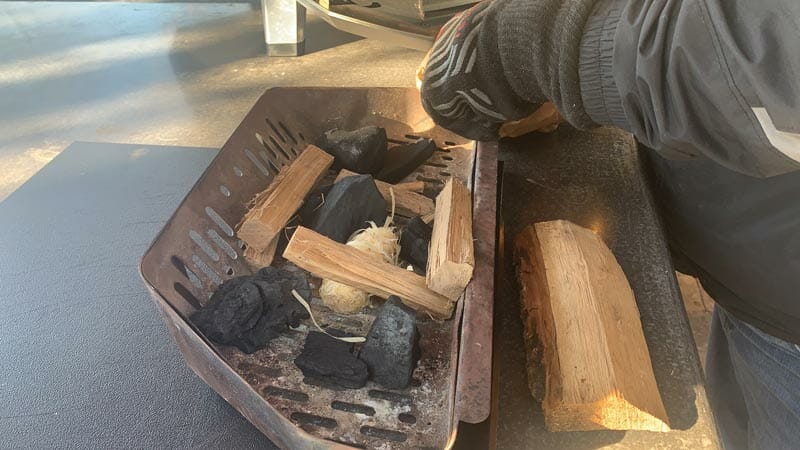
The Ooni Karu 12 has a very similar setup including a removable ash pan. Unlike the Pi, the ash pan on the Karu goes in and out through the front door of the pizza oven. Once the fire is going and has been placed in and pushed to the back of the wood oven, additional fuel can then be added through a hatch door on the back of the unit.
When cooking wood-fired pizzas, managing your fire is critical and observing your wood-burning stone temperature frequently helps to inform your fire management. In pizza ovens of this size, the wood you’re using will be quite small and will need to be replaced often to maintain the proper temperature.
Gas Burner Option
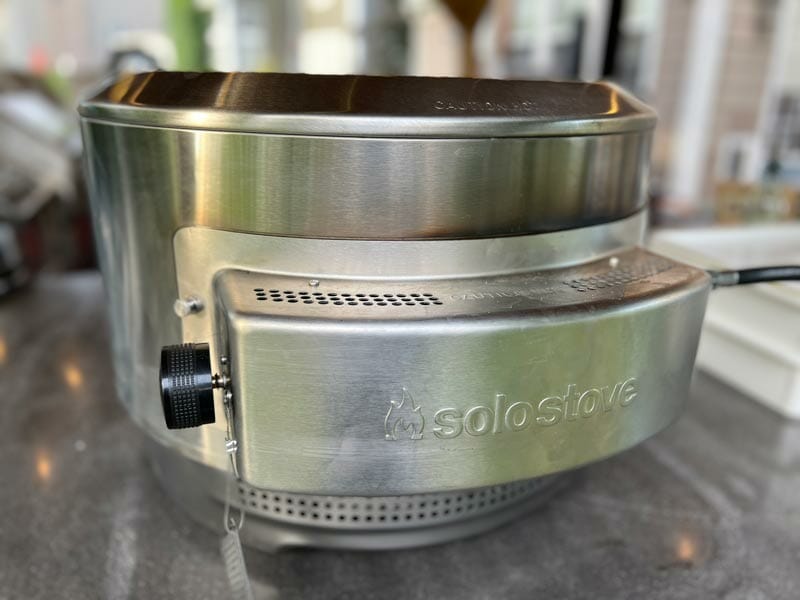
For an additional expense, both the Solo Stove Pi and the Ooni Karu can become a dual fuel oven with the addition of a gas burner. The gas burner hooks up to a propane tank. The propane-fueled flames are easily adjusted higher or lower with the turn of a knob. The Solo Stove gas burner retails for $269.99 (but is frequently on sale; currently $174.99 as I type this) and the Ooni gas burner retails for $99.99.
What’s the difference between cooking with wood and cooking with gas?
Believe it or not, your pizza won’t taste differently if it’s cooked with wood rather than gas. In fact, more often than not, when we’ve given our guests a blind taste test, they typically guess the pizza cooked with gas as the one having the wood-fired flavor.
The true difference doesn’t come in the flavor, it comes in the ease of cooking. It is much easier to operate a pizza oven fueled by propane rather than wood, just like it’s much easier to operate a grill fueled by gas rather than charcoal.
Another difference we found is that we were able to get the Solo Stove Pi quite a bit hotter when using the gas burner than we were with wood.
Solo Stove Pi Tips and Tricks
Cleaning the Outside of your Pi Pizza Oven
If you’re burning wood, the outside of your fire pit will definitely accumulate soot above the front opening. This cleans off easily with warm soapy water and a microfiber cloth. We also like using Bar Keeper’s Friend, which we also use to occasionally tidy up our Solo Stove fire pits and other outdoor kitchen appliances.
Cleaning the Inside of your Pi Pizza Oven
Don’t clean the inside of your outdoor pizza oven. And what I really mean is, no matter how big of a mess you might have made on your pizza stone, do not attempt to pull the stones out and give them a good scrub in the sink. Instead, get your fire as good and hot as you can and let the heat incinerate the mess; much like the cleaning cycle of your indoor oven.
Maintain Access to the Back of the Oven
Think about where you’ll be setting up your new Solo Stove Pi before you order. Do you have an existing counter in your outdoor space or will you be setting up a table or a cart to set it on? Be sure that wherever you plan to set up your outdoor pizza oven, you still have access to the back in order to add wood or adjust the gas burner.
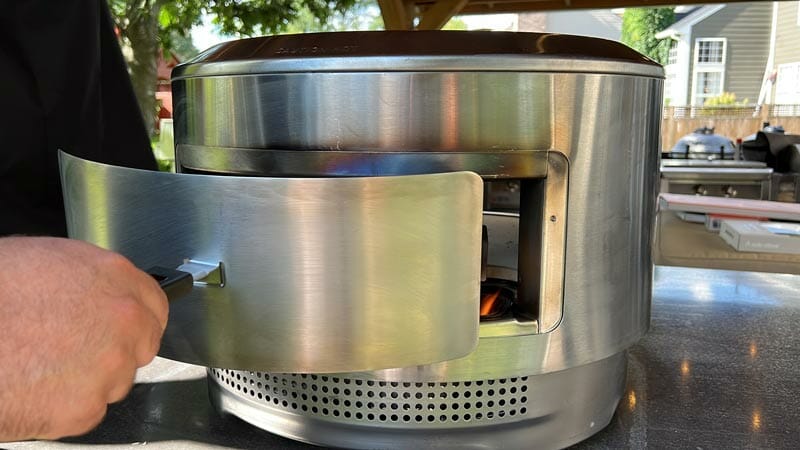
Practice, Practice, Practice.
I hate to burst your bubble, but you probably won’t be cooking restaurant-quality pizzas on your first try with your new outdoor pizza oven. And it has absolutely nothing to do with the quality or function of the Solo Stove Pi pizza oven, but everything to do with the level of difficulty when it comes to transferring pizza dough from a peel to a hot backyard pizza oven. It’s a new skill and it’s not easy. You’ll mess up a few times. We all do, whether we admit it or not. But it is a skill that can 100% be learned. It’s not a bad idea to start with a frozen pizza or two just do get down the basics of fire management, monitoring pizza stone temperature with your infrared thermometer, and turning your homemade pizza mid-cook. But once you start making homemade pizzas from scratch, make some extra dough “just in case”.
Is the Solo Stove Pi Pizza Oven worth it?
So the question is, is the Solo Stove Pi the right outdoor pizza oven for you to make your own backyard artisan personal-size pizzas?
It’s a great pizza oven! I admit I liked it better with the propane burner than without. I think the wood we were using wasn’t cut small enough and we just had a real tough time getting the temperature as hot as we like it for cooking homemade pizzas. The propane option just makes it so easy to use.
If you love Solo Stove fire pits, you’ll certainly love their new pizza oven as well. If you’re comparing prices between the Ooni Karu 12 and the Solo Stove Pi, the Karu certainly retails at a better price. However, Solo Stove frequently runs sales on the pizza oven and other products, so keep your eye out and it sometimes bumps down to roughly the same price as the Ooni Karu (which almost never goes on sale). You certainly can’t argue with the lifetime warranty and top-notch customer service that comes with the Solo Stove!


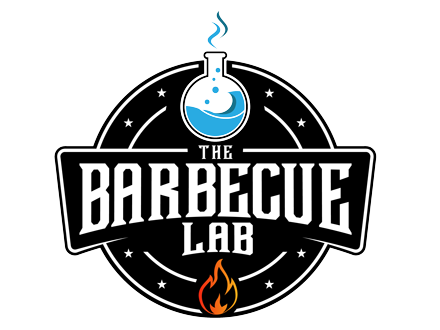
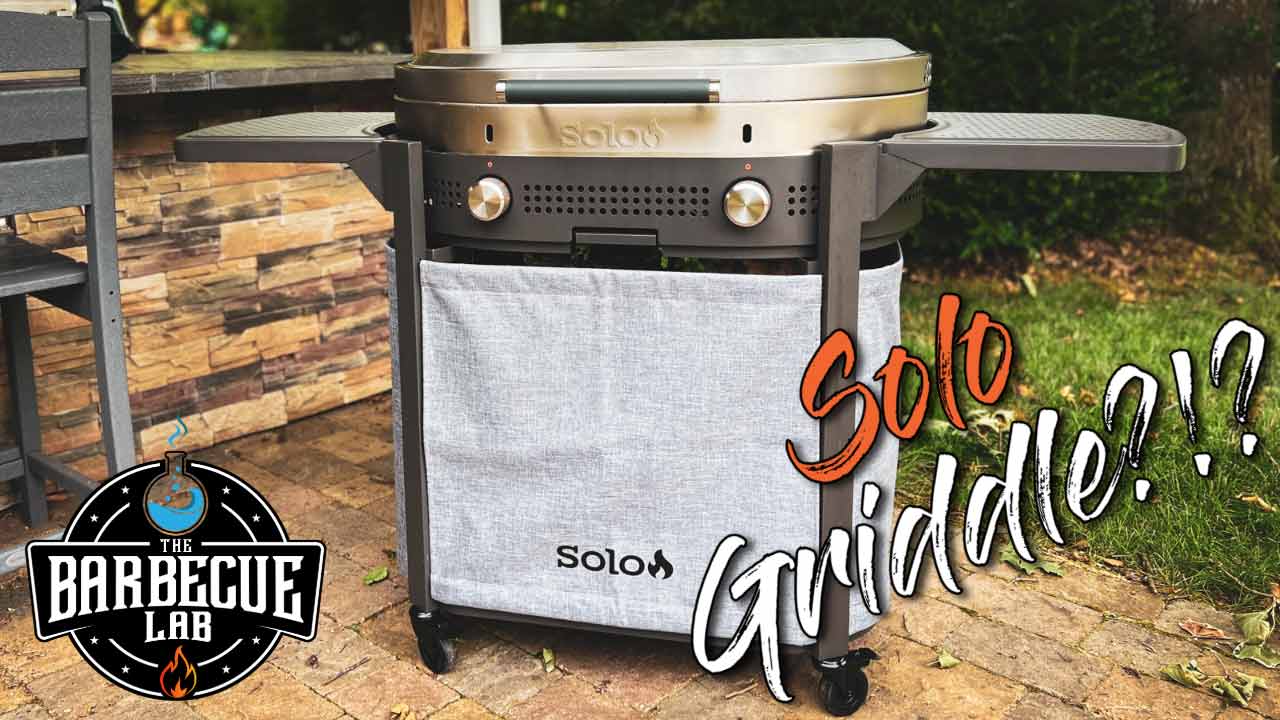


Leave a Comment